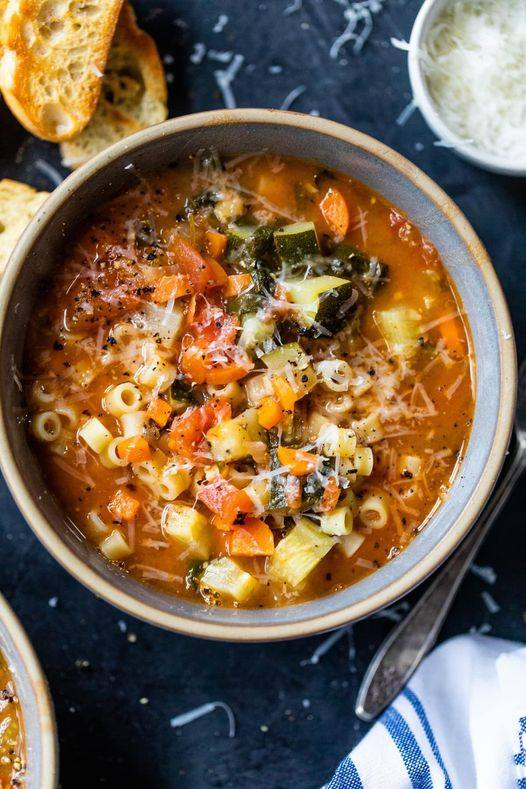Minestrone soup is an iconic dish with a rich history and a vibrant presence in Italian cuisine. Its name, derived from the Italian word “minestra” which means “soup,” indicates its roots as a substantial, hearty meal. This traditional soup is beloved for its versatility and the way it beautifully showcases the bounty of seasonal vegetables. Originating from the rustic kitchens of Italy, minestrone has evolved over centuries, adapting to regional ingredients and culinary traditions, which makes it a true representation of Italian home cooking. Each bowl tells a story of the land, the seasons, and the hands that prepare it.
The essence of minestrone lies in its ability to transform humble ingredients into a satisfying and nourishing meal. Historically, it was a dish made by farmers and peasants who relied on their garden’s produce and pantry staples. This adaptability means there is no single “correct” way to make minestrone. Instead, it thrives on the use of whatever vegetables are fresh and available, often featuring beans, pasta, and sometimes rice or potatoes. This flexibility is part of what makes minestrone a timeless favorite, able to be customized to suit any taste or dietary need.
One of the beauties of minestrone is its celebration of vegetables, making it not only delicious but also incredibly healthy. The combination of tomatoes, leafy greens, root vegetables, and legumes provides a wealth of vitamins, minerals, and fiber. This makes minestrone not only a comfort food but also a nourishing option that can be enjoyed by people of all ages. The inclusion of beans adds protein and a creamy texture, while the vegetables bring a variety of flavors and colors, making each spoonful a delightful experience.
A classic minestrone soup also incorporates aromatic herbs and spices, which enhance its flavor and give it a distinct Italian flair. Ingredients like garlic, onions, basil, oregano, and bay leaves are typically used to create a rich, fragrant broth that forms the backbone of the soup. Sometimes, a piece of Parmesan rind is added during cooking to infuse the soup with a deep, savory note. The use of olive oil, a staple in Italian cooking, adds a luscious finish and helps to meld the flavors together.
The process of making minestrone is as comforting as the soup itself. It begins with sautéing the aromatics, such as onions, garlic, and celery, which forms the base layer of flavor. Then, the harder vegetables, like carrots and potatoes, are added and cooked until tender. Tomatoes, either fresh or canned, are a key ingredient that adds acidity and depth. The broth, usually vegetable or chicken, is poured in, and the mixture is simmered until all the flavors are married. Near the end of cooking, leafy greens, pasta, and beans are added to complete the soup.
Minestrone’s enduring appeal also lies in its communal nature. It is a dish meant to be shared, bringing people together around a pot of simmering goodness. Whether served as a starter or as the main course, minestrone invites conversation and connection. Its ability to warm both the body and the soul makes it a perfect dish for family gatherings, cozy dinners, and even festive occasions. In every spoonful of minestrone, there is a taste of tradition, comfort, and the simple joys of life.
The Best Minestrone Soup Recipe

Ingredients:
15 ounce can white beans (drained, rinsed (cannellini beans or navy beans))
32 oz container reduced sodium chicken broth (or vegetable broth for vegan)
2 teaspoons olive oil
1/2 cup chopped onion
1 cup diced carrots
1/2 cup diced celery
2 garlic cloves (minced)
28 oz can petite diced tomatoes
Parmesan cheese rind (optional)
1 fresh rosemary sprig
2 bay leaves
2 tbsp chopped fresh basil
1/4 cup chopped fresh Italian parsley
1/2 tsp kosher salt
fresh black pepper
1 medium zucchini (about 8 oz each, diced)
2 cups spinach (chopped fresh, if frozen defrosted)
2 cups cooked small pasta such as ditalini or orzo (al dente (or gluten-free pasta)*)
extra parmesan cheese for garnish (optional)
Instructions:
Puree beans with 1 cup of the broth in a blender.
Heat oil in a large Dutch oven or pot over medium-high heat. Add the carrots, celery, onion, garlic and stir, saute until tender and fragrant, about 15 minutes.
Add the remaining broth, tomatoes, pureed beans, parmesan cheese rind if using, salt and pepper. Add the rosemary, bay leaves, basil and parsley, bring to a boil, then cover and cook on low 40 minutes.
Add the zucchini and spinach, cover and simmer until the zucchini is tender, about 8 to 10 minutes.
Remove the bay leaves, rosemary sprig, Parmesan rind and season to taste with salt and black pepper.
Ladle 1-1/4 cups soup into 8 bowls with 1/4 cup pasta in each and top with extra parmesan cheese if desired.
Notes
From around 4 or 5 ounces dry pasta. I like to cook the pasta separately so that it stays al dente and doesn’t soak up the broth. If you want to cook it in the soup, cook it in the end.
Nutrition
Serving: 11/2 cups, Calories: 175kcal, Carbohydrates: 31.5g, Protein: 8g, Fat: 2g, Sodium: 358mg, Fiber: 5g, Sugar: 5g
– W/W Points: 2
